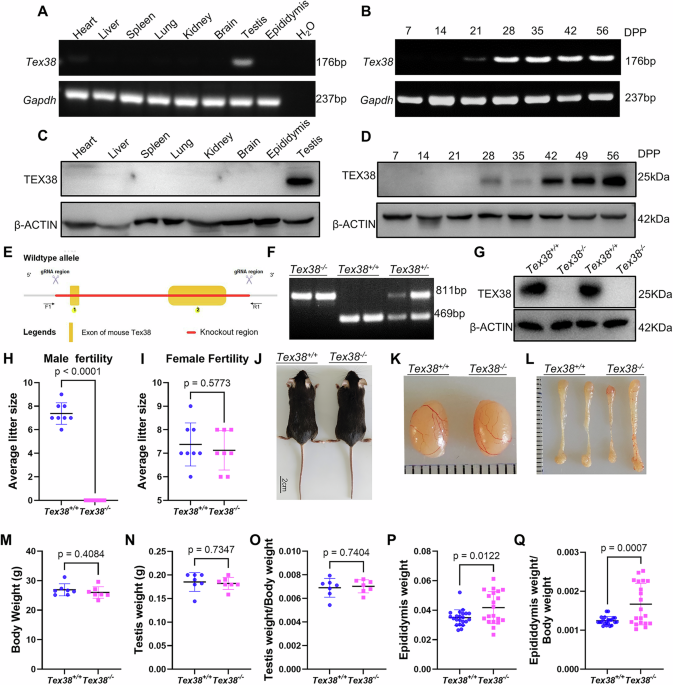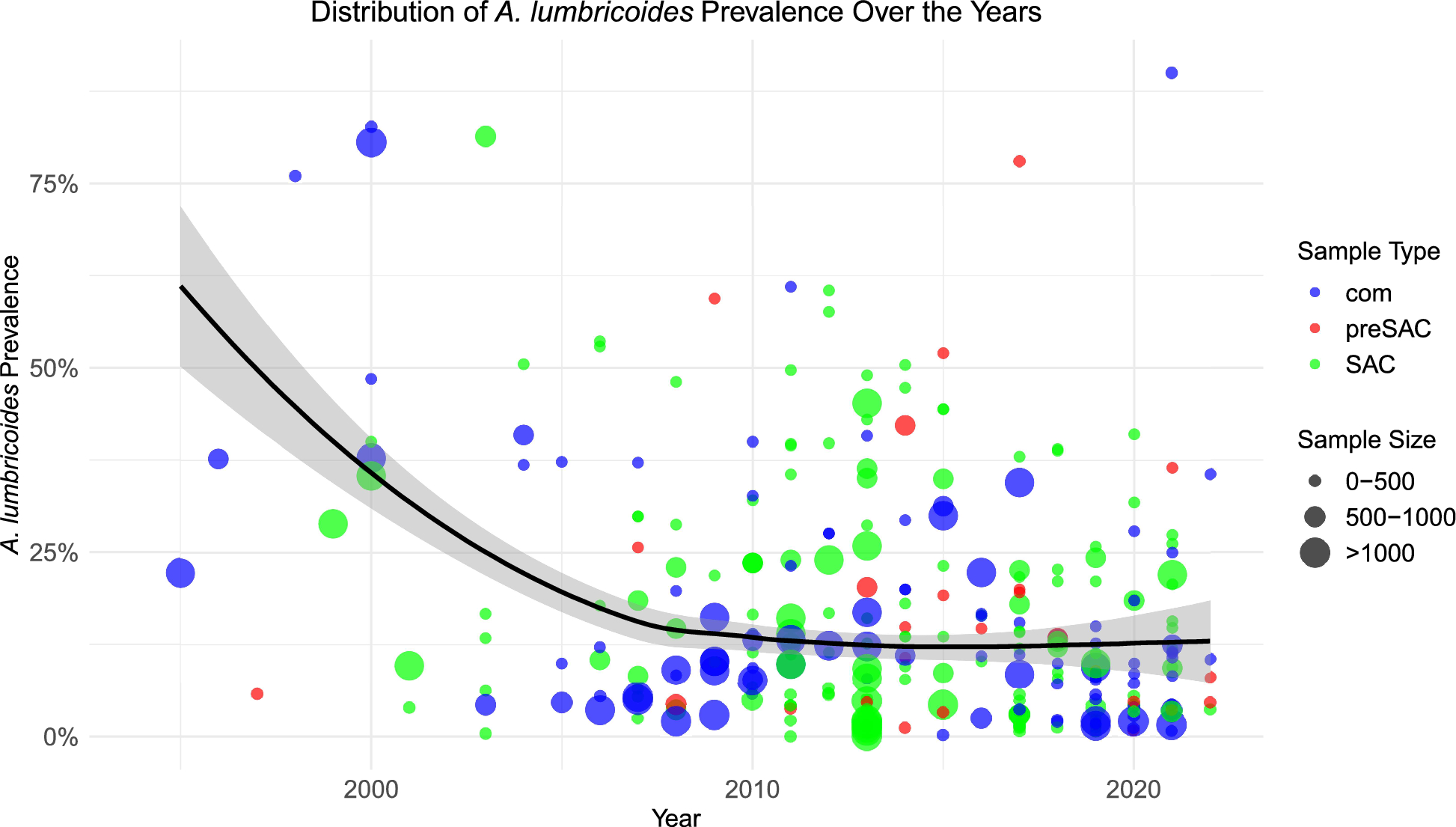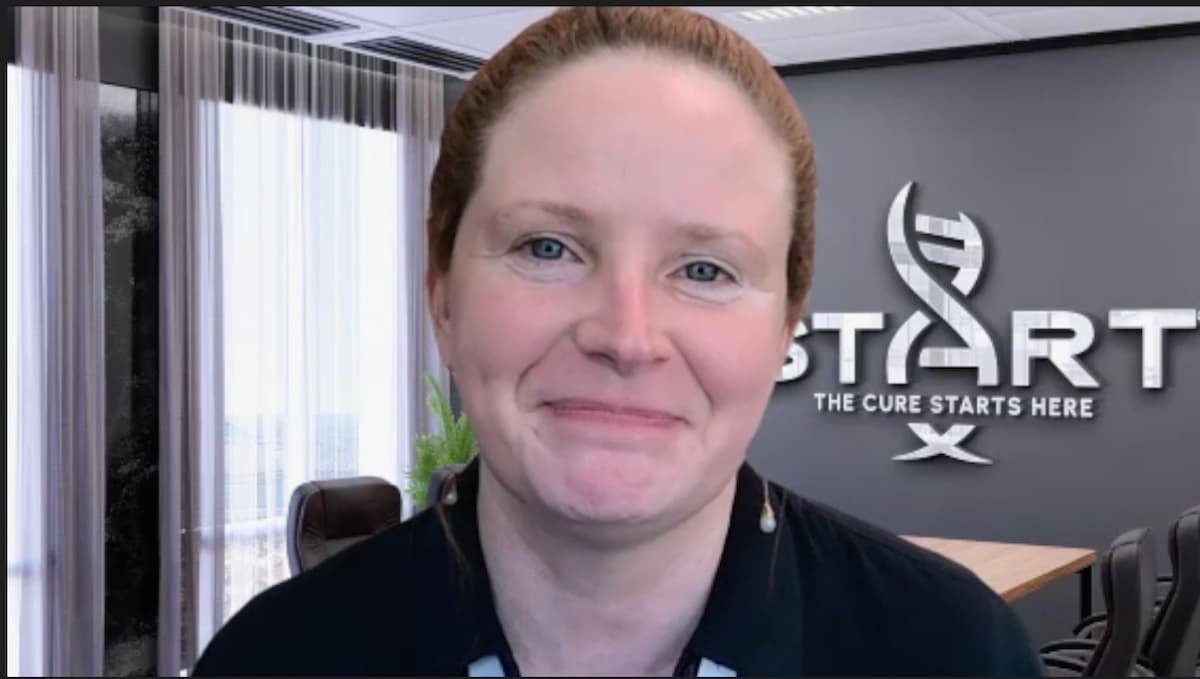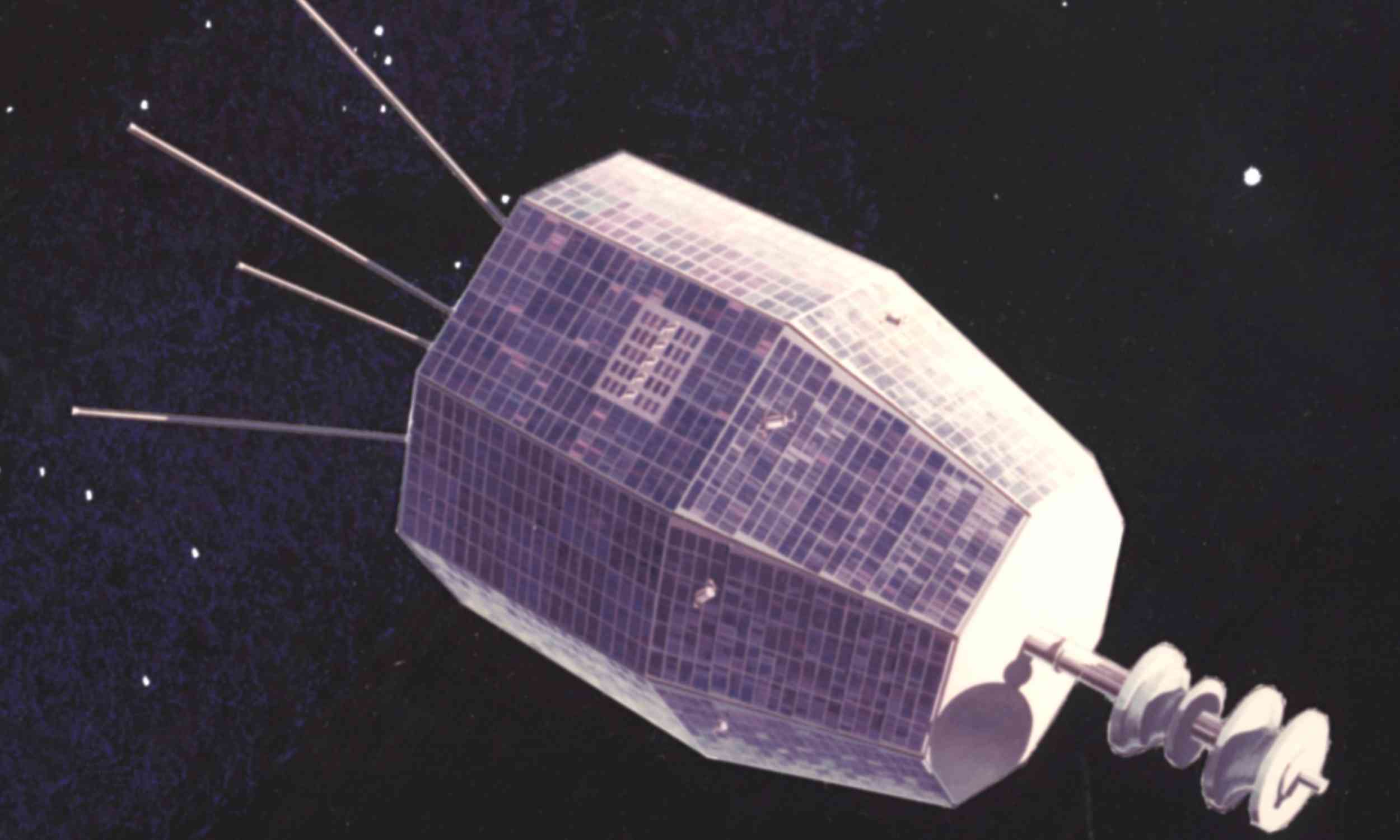Tex38 is an evolutionarily conserved gene predominantly expressed in the testis
To explore the evolutionary history of Tex38, we initially utilized the Ensembl comparative genomics resources (https://asia.ensembl.org/index.html) to construct the phylogenetic tree of Tex38. We observed that Tex38 first appeared in amniotes and is mainly expressed in mammals (Fig. S1A). Alignment analyses (https://www.uniprot.org/) of TEX38 orthologs from mice, rats, bovines, chimpanzees, horses, macaques, and humans revealed high homology throughout evolution (Fig. S1B). TEX38 orthologs exhibited significant sequence identity, ranging from 70.47% to 95.15% (Fig. S1C). The FANTOM5 dataset in the Human Protein Atlas (https://www.proteinatlas.org/) demonstrated that TEX38 is predominantly expressed in the testis, with a moderate expression level in the epididymis (Fig. S1D). Additionally, human single-cell RNA sequencing data revealed specific expression of TEX38 in both early and late spermatids (Fig. S1E). Furthermore, transcriptomic analysis of mouse tissues (https://www.ncbi.nlm.nih.gov/) indicated that Tex38 is predominantly expressed in the testis (Fig. S1F). Consistent with human data, single-cell sequencing data from databases (https://smart-db.cn/home) showed that Tex38 is primarily expressed in round spermatids in mouse testes (Fig. S1G). To elucidate the expression pattern of the Tex38 gene in mice, we performed reverse transcription polymerase chain reaction (RT-PCR) analysis using cDNA samples from multiple organs. Tex38 mRNA was detected only in the testis, with no evident PCR product bands observed in other tissues (Fig. 1A). TEX38 protein was detected with predominant expression in the testis (Fig. 1C). Additionally, we analyzed the expression patterns of Tex38 mRNA and protein in mouse testes at different developmental stages. Tex38 mRNA was first detected at 21 days postpartum (dpp), while TEX38 protein was first detected at 28 dpp. Both mRNA and protein remained at high levels until adulthood (Fig. 1B, D), coinciding with the appearance of elongating spermatids. These results demonstrate that Tex38 is predominantly expressed in the mouse testis, and this specific expression pattern suggests a potentially important role for TEX38 in spermatogenesis.
A RT-PCR analysis of Tex38 mRNA in mouse tissues. Gapdh was used as an endogenous control. B RT-PCR analysis of Tex38 mRNA in the testis of mice at different ages. Gapdh was used as an endogenous control. C Western blot of TEX38 protein in mouse tissues. β-actin was used as a loading control. D Western blot of TEX38 protein in the testis of mice at different ages. β-actin was used as a loading control. E Schematic diagram of generating Tex38-knockout mouse model (Tex38−/−) by CRISPR/Cas9 system. F DNA genotyping analysis of mice by RT-PCR. Homozygous (Tex38−/−) 811 bp, heterozygous (Tex38+/−) 811 bp and 469 bp, WT (Tex38+/+) 469 bp. G Western blot showed that TEX38 was deleted in 8-week-old Tex38−/− testis compared to Tex38+/+. β-actin was used as the loading control. H, I The number of litter size in Tex38−/− and Tex38+/+ females and males mated with Tex38+/+ mice (n = 8). Student’s t-test. J–L Photographs of adult mice with Tex38+/+ and Tex38−/− showing external appearance and images of testes and epididymis. M–O Body weight, testis weight and testis weight to body weight ratio of Tex38+/+ and Tex38−/− mice at 8 weeks (n = 7). Student’s t-test. P, Q Epididymis weight and epididymis weight to body weight ratio of adult Tex38+/+ and Tex38−/− mice (n = 10). Student’s t-test. All error bars show SEM.
Due to limitations in antibody availability, direct detection of TEX38 localization within testicular tissue was not feasible. To elucidate its subcellular localization, we conducted an amino acid sequence analysis of TEX38, identifying a transmembrane region spanning amino acids 4-26. Subsequently, we constructed an EGFP-TEX38 plasmid encompassing the full-length TEX38 sequence and a mutant plasmid lacking the transmembrane domain (Fig. S2A). EGFP was fused to the N-terminus of the TEX38 protein. These plasmids were transfected into HeLa cells, and the distribution of the EGFP signal was observed following protein expression. The full-length EGFP-TEX38 protein exhibited predominant perinuclear localization with a punctate pattern, whereas both EGFP alone and the EGFP-TEX38 mutant protein were uniformly distributed throughout the cell (Fig. S2B). To further define the subcellular localization of the EGFP-TEX38 fusion protein, transfected HeLa cells were stained with fluorescent probes targeting the endoplasmic reticulum (ER), Golgi apparatus, mitochondria, and lysosomes. Significant co-localization between the EGFP-TEX38 fusion protein and probes for the ER and Golgi apparatus was observed in the perinuclear region, while minimal co-localization was detected with mitochondrial and lysosomal probes (Fig. S2C). These findings indicate that TEX38 plays a functional role in multiple cytoplasmic organelles, with emphasis on the ER and Golgi apparatus.
Deficiency of Tex38 causes male infertility
To further clarify the function of Tex38, we generated a Tex38−/− mouse model through the CRISPR-Cas9 genome editing system. Two sgRNAs were designed targeting exons 1 and 2 of Tex38 (Fig. 1E). Genotyping was performed by PCR (Fig. 1F). Western blot analysis confirmed the deletion of TEX38 protein (Fig. 1G). Fertility testing revealed that Tex38−/− male mice were completely infertile (Fig. 1H), whereas females exhibited normal fertility comparable to Tex38+/+ females (Fig. 1I). No significant differences were observed in the morphology, testis size, body weight, testis weight, or testis-to-body weight ratio between Tex38−/− and age-matched Tex38+/+ mice (Fig. 1J, K, M–O). These findings suggest that Tex38 deficiency has no effect on mouse growth and development. Interestingly, a subset of Tex38−/− mice displayed markedly enlarged epididymides compared to Tex38+/+ mice (Fig. 1L). Tex38−/− mice also exhibited a significantly increased epididymis weight/body weight ratio compared to Tex38+/+ mice (Fig. 1P, Q). Overall, these results indicate that Tex38 is essential for male fertility in mice and contributes to the regulation of epididymal weight.
Deficiency of Tex38 causes oligoasthenozoospermia in male mice
To investigate the role of Tex38 in spermatogenesis, histological examination was conducted on the caput, corpus, and cauda regions of Tex38+/+ and Tex38−/− epididymis (Fig. 2A). Hematoxylin and eosin (H&E) staining revealed that sperm within the epididymis of Tex38−/− mice exhibited abnormal morphology and reduced numbers, whereas the morphology of epithelial cells in the caput, corpus, and cauda epididymides appeared normal in Tex38−/− mice (Fig. 2A). Sperm count analysis revealed that compared to Tex38+/+, Tex38−/− mice exhibited a significant reduction in sperm abundance released from the cauda epididymis (Fig. 2B). Furthermore, reductions in both the proportion of motile spermatozoa and sperm with progressive motility were noted (Fig. 2C, D). Morphological analysis of cauda epididymal sperm revealed a significant increase in bent-neck spermatozoa in Tex38−/− mice (KO 63.3% vs WT 2.0%, P < 0.001), accompanied by other morphological abnormalities including spermatozoa with malformed heads (KO 26.8% vs WT 14.2%, P < 0.001) and multi-headed/flagellated (KO 5.5% vs WT 0.0%, P < 0.05) sperm (Fig. 2E, F). These aberrant morphological patterns were consistently observed through scanning electron microscopy (SEM) (Fig. 2G). To explore sperm defects in greater detail, sperm collected from the cauda epididymis were examined using transmission electron microscopy (TEM). In Tex38−/− spermatozoa, both the head and the midpiece of the tail were simultaneously enveloped within a membranous structure (Fig. 2H). Compared to Tex38+/+ mice, the cross-sections of sperm flagella from Tex38−/− mice exhibited clear evidence of axoneme damage, as well as disorganization of the mitochondrial sheath and outer dense fibers (Fig. 2H). Meanwhile, acrosome morphology was examined in Tex38+/+ and Tex38−/− sperm using PNA-FITC immunofluorescence staining (IF). A significant deviation from the normal acrosomal pattern was observed in Tex38−/− sperm, characterized by absent or abnormally located PNA-labeled acrosome signals. Notably, most sperm with neck bending displayed weak, diffuse acrosomal staining, with only 27.1% exhibiting normal PNA-positive signals (Fig. 2I, J). Given the abnormal head morphology (22.9%) observed in Tex38−/− sperm, DNA damage was assessed in epididymal sperm. A significantly higher proportion of comet-positive sperm was detected in Tex38−/− compared to Tex38+/+ mice (KO 27.1% vs WT 3.7%, P < 0.01), indicating increased DNA damage in Tex38−/− sperm (Fig. 2K, L). These findings collectively demonstrate that Tex38 deletion results in OAT in mice.
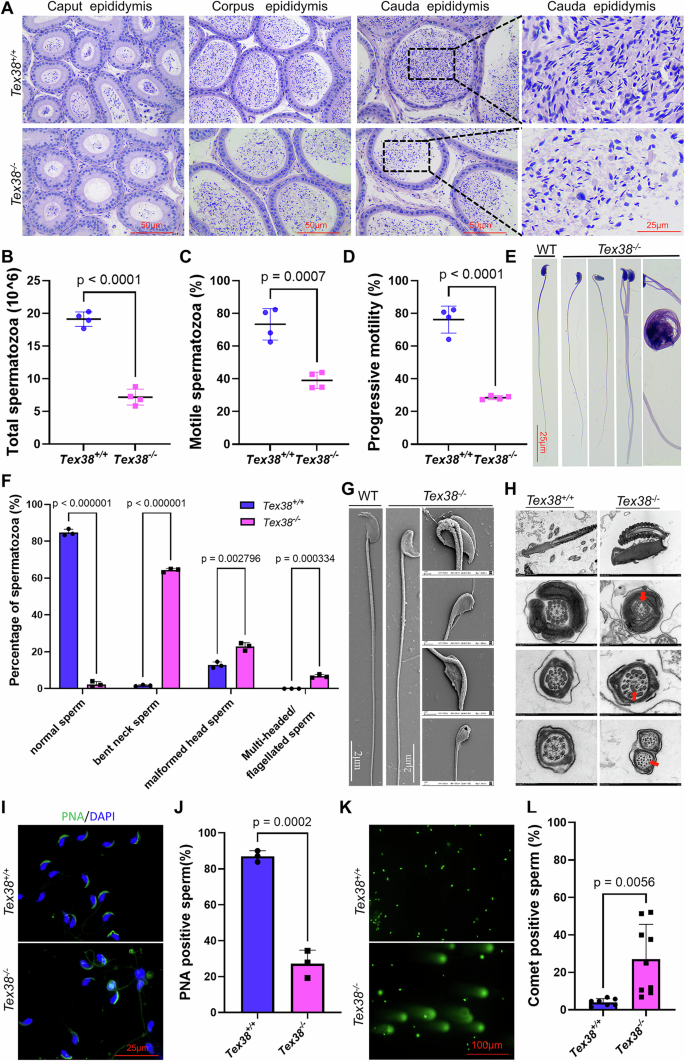
A H&E staining of the caput epididymis, corpus epididymis, and cauda epididymis from Tex38+/+ mice and Tex38−/− mice. B Count of the sperm from cauda epididymis (n = 3). Student’s t-test. C The percentage of motile spermatozoa in the cauda epididymis (n = 3). Student’s t-test. D The percentage of the sperm with progressive motility in the cauda epididymis (n = 3). Student’s t-test. E H&E staining of spermatozoa from the cauda epididymis. F The percentage of normal sperm, bent neck sperm, malformed head sperm, and multi-headed/flagellated sperm in Tex38+/+ and Tex38−/− cauda epididymis (n = 3). Student’s t-test. G Scanning electron microscopy (SEM) images of sperm from Tex38+/+ and Tex38−/− mice. H TEM analysis of mature sperm in the Tex38+/+ and Tex38−/− cauda epididymis. The red arrow indicates the absence and disorder of microtubules in the sperm flagella of Tex38−/− mice. I Peanut agglutinin (PNA) staining of epididymal sperm from Tex38+/+ and Tex38−/− mice. Scale bar is 25 μm. J Quantification of the percentage of PNA positive sperm in Tex38+/+ and Tex38−/− mice (n = 3, more than 200 sperm per replicate). Student’s t-test. K, L Comet assay for DNA fragmentation of epididymal sperm from Tex38+/+ and Tex38−/− adult mice (n = 9, more 500 sperm per replicate). Scale bar is 50 μm. Student’s t-test.
Tex38 deficiency affects spermiogenesis but may not affect spermatogonial proliferation or meiosis
To investigate the role of Tex38 in mice, we further performed HE staining to analyze the tissue morphology of Tex38+/+ and Tex38−/− mice. No substantial differences were observed in the heart, liver, spleen, lungs, kidneys, and brain (Fig. S3A). These results demonstrate that Tex38 primarily functions within testicular tissue. To assess the cause of oligoasthenozoospermia induced by Tex38 deletion, we conducted a detailed analysis of the testicular histomorphology in Tex38−/− mice. Periodic Acid-Schiff (PAS) staining revealed that the number and diameter of seminiferous tubules in Tex38−/− mice were comparable to those in Tex38+/+ mice. Histological examination of 12 spermatogenic stages revealed elongated spermatids with delayed release during stages IX-X, along with failed individualization at the basal compartment of seminiferous tubules, which were not observed in Tex38+/+ mice. No significant abnormalities in cellular arrangement were detected in other spermatogenic stages (Fig. 3A). To clarify the impact of Tex38 on spermatogenesis, we quantified various types of germ cells at different stages. There was no significant difference in the number of germ cells in Tex38−/− testes compared to Tex38+/+ testes, except for an increase of unreleased elongated spermatids in stage IX-X seminiferous tubules (Fig. 3B).
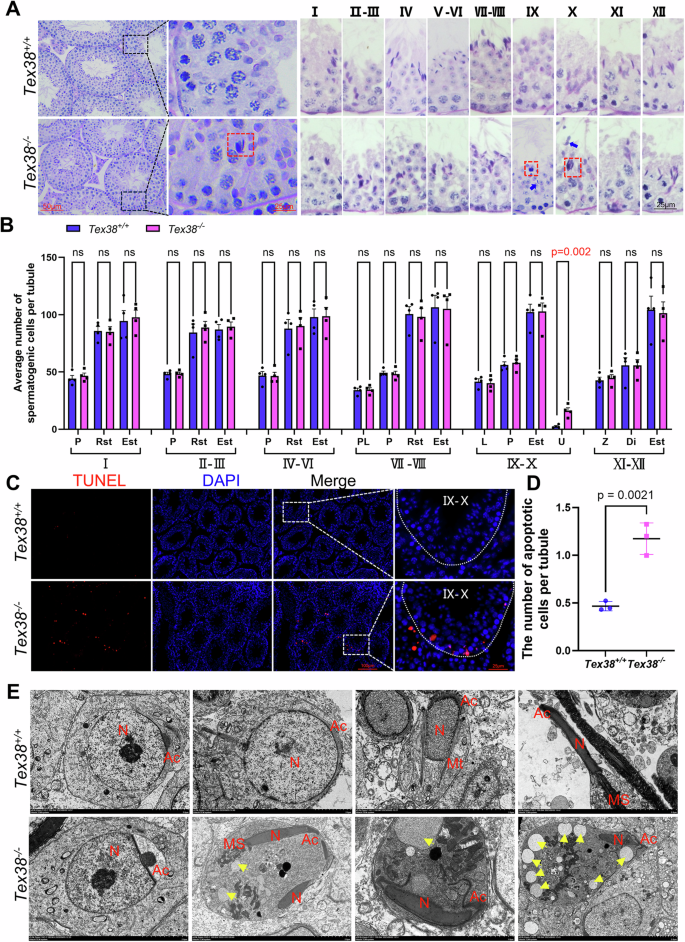
A Different epithelium stages of seminiferous tubules in PAS-stained Tex38+/+ and Tex38−/− testes. The red dashed box indicates sperm with individualization failure, while the blue arrows indicate unreleased elongated sperm. Scale bar is 25 μm. B Spermatogenic cell count and statistical analysis of spermatogenic tubules at different stages. Leptotene (L), zygotene (Z), pachytene (P), diplotene (Di), round spermatid (Rst), elongated spermatid (Est), unreleased sperm (U). n = 4, Student’s t-test. C, D TUNEL staining of testis sections from Tex38−/− and Tex38+/+ mice (n = 3). Student’s t-test. Scale bar is 50 μm. E TEM images for testes from Tex38−/− and Tex38+/+ adult mice. Yellow arrows indicate abnormal vesicles. N nucleus, Ac acrosome, Mt manchette, MS mitochondrial sheath. Scale bar is 2 μm.
To determine the specific stage of spermatogenesis in which Tex38 functions, we further examined the expression of germ cell markers (VASA for germ cells, PCNA for spermatogonia, γ-H2AX for spermatocytes). There were no significant differences in terms of the expression and localization of these molecules in Tex38+/+ and Tex38−/− testes. Tex38−/− did not affect the number of various spermatogenic cells, the differentiation of spermatogonia, or the meiosis of spermatocytes (Fig. S3B–D). SOX9 staining and quantification also indicated no significant impact of Tex38 deletion on the number and localization of Sertoli cells (Fig. S3E, F). We performed TUNEL staining to analyze cell apoptosis in Tex38−/− testis, which revealed a significantly increased number of apoptotic cells than in Tex38+/+ testis (Fig. 3C, D). Further observation of the ultrastructure of various cells in testis tissues using transmission electron microscopy (TEM) showed that most cells in Tex38−/− testes exhibited no significant abnormalities. However, a few round spermatids with acrosome vacuolation and multinucleated cell clusters containing multiple sperm heads were observed. These clusters included sperm heads, dispersed acrosomes, sperm flagella, and multiple vacuoles (Fig. 3E). Collectively, Tex38 knockout primarily affects spermiogenesis, while potentially having no significant impact on spermatogonial proliferation and spermatocyte meiosis.
Progressive increase of bent-neck sperm during the transit in the epididymis of Tex38
−/− mice
To study the etiology of abnormal sperm in Tex38−/− males, spermatozoa were collected from the testis, caput epididymis, corpus epididymis, and cauda epididymis for analysis of morphological abnormalities. Abnormal sperm morphology was observed in Tex38−/− males, including multi-headed/flagellated, bent-neck, malformed head (Fig. 4A, B). Compared with Tex38+/+ mice, the percentages of abnormal spermatozoa from the testis, caput epididymis, corpus epididymis, and cauda epididymis of Tex38−/− mice were significantly increased (Fig. 4B). H&E staining of testicular spermatozoa within seminiferous tubules revealed no significant difference in the proportions of bent-neck spermatozoa between Tex38−/− and Tex38+/+ mice (Fig. 4C). While multi-headed/flagellated spermatozoa were absent in Tex38+/+ mice, they constituted 3.2% of spermatozoa in the testes of Tex38−/− mice, a proportion consistent with that observed in the epididymis, suggesting that these abnormal spermatozoa originated in the testis (Fig. 4C). Statistical analysis demonstrated a progressive increase in the percentage of bent-neck spermatozoa from the caput epididymis (22.9%) to the corpus epididymis (46.2%) and cauda epididymis (62.0%), indicating that normal spermatozoa released into the lumen of seminiferous tubules subsequently undergo transformation into bent-neck spermatozoa during epididymal transit from the caput to the cauda epididymis (Fig. 4C).
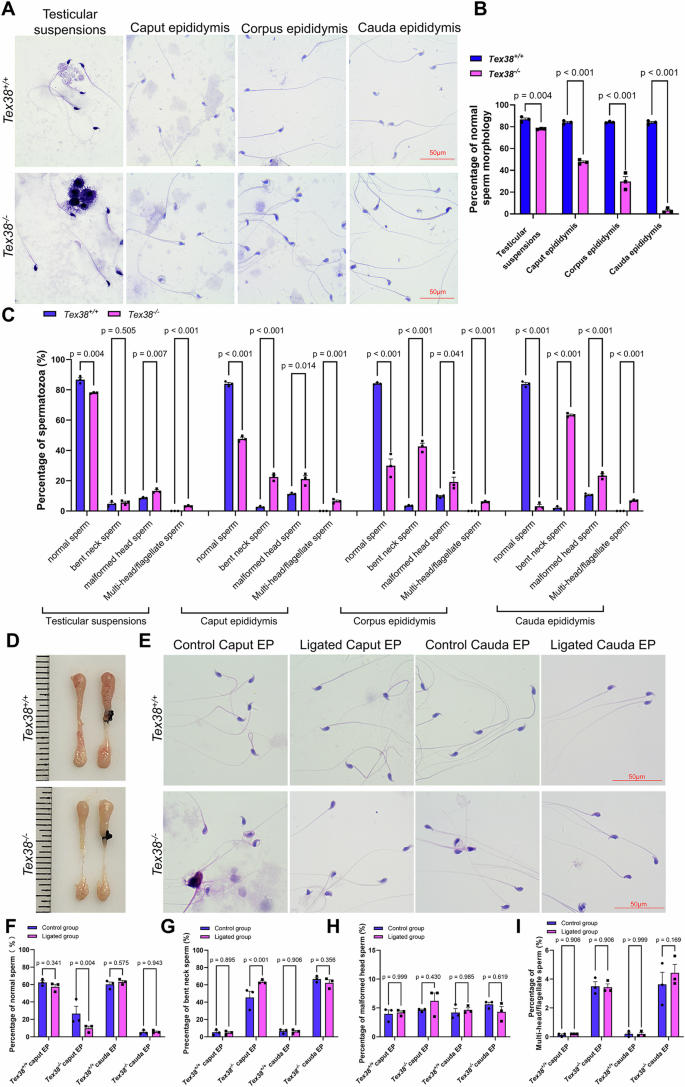
A H&E staining of sperm collected from testis, caput epididymis, corpus epididymis, and cauda epididymis of Tex38−/− and Tex38+/+ mice (n = 3). B, C Percentages of abnormal morphology sperm in testicular suspensions, caput epididymis, corpus epididymis, and cauda epididymis of Tex38−/− and Tex38+/+ mice (n = 3, more than 200 sperm per replicate). Student’s t-test. D The representative images of epididymides from Tex38+/+ and Tex38−/−mice after ligation for 4 days. The one side epididymal ducts were ligated at the corpus region, and the other epididymis was removed from the abdominal cavity and then placed back as a sham ligation control. E H&E staining was used to analyze the sperm of the caput epididymis and cauda epididymis after ligation for 4 days. EP epididymis. F The percentages of normal sperm in caput and cauda epididymis of Tex38−/− and Tex38+/+ mice after ligation for 4 days (n = 3). Student’s t-test. G The percentages of bent neck sperm in caput and cauda epididymis of Tex38−/− and Tex38+/+ mice after ligation for 4 days (n = 3). Student’s t-test. H The percentages of malformed head sperm in caput and cauda epididymis of Tex38−/− and Tex38+/+ mice after ligation for 4 days (n = 3). I The percentages of multi-headed/flagellated sperm in caput and cauda epididymis of Tex38−/− and Tex38+/+ mice after ligation for 4 days (n = 3). Student’s t-test. Data are presented as mean ± SEM. Student’s t-test. All data are mean ± SEM and dots represent values for individual mice.
To elucidate whether the observed changes were induced by an aberrant epididymal environment due to Tex38 deficiency or prolonged sperm storage, epididymal duct ligation was performed. The left corpus epididymis was ligated for four days in both Tex38−/− and Tex38+/+ mice to simulate epididymal sperm storage, while the contralateral epididymis served as a control (Fig. 4D). Four days post-ligation, both Tex38−/− and Tex38+/+ mice exhibited a substantial accumulation of spermatozoa in the caput region. Subsequent H&E staining analysis of sperm collected from the caput and cauda was conducted (Fig. 4E). Compared to the non-ligated Tex38−/− epididymis, the proportion of bent-neck sperm in the caput region of Tex38−/− mice increased significantly post-ligation, while the proportion of normal sperm was significantly decreased post-ligation, reaching a similar proportion to that observed in the cauda epididymis (Fig. 4F, G). Conversely, no significant changes were observed in the percentages of multi-headed/flagellate sperm or malformed head sperm in the Tex38−/− caput region four days post-ligation (Fig. 4H, I). These findings suggest a positive correlation between the formation of bent-neck sperm and sperm storage duration within the Tex38−/− epididymis. Consequently, we hypothesize that the presence of bent-neck sperm in Tex38−/− mice is primarily attributed to epididymal storage, regardless of storage in caput or cauda region.
Tex38 deficiency leads to sperm dysfunction and fertilization failure
To elucidate the underlying causes of male infertility in Tex38−/− mice, we comprehensively evaluated the functionality of Tex38−/− spermatozoa at various stages of fertilization, including acrosome reaction (AR), and zona pellucida (ZP) binding. To further induce the AR, capacitated sperm were exposed to the Ca2+ ionophore A23187 in vitro. Given that sperm undergoing the AR are not stained by PNA, this enabled quantification of AR occurrence. Unexpectedly, a substantial proportion of Tex38−/− sperm retained PNA staining post-ionophore treatment, with only 3.3% exhibiting the AR, significantly lower than the 70.8% observed in Tex38+/+ sperm (Fig. 5A, B). The fertilization capacity of Tex38−/− spermatozoa was assessed through in vitro fertilization assays. In contrast to Tex38+/+ sperm, which efficiently bound to the ZP, Tex38−/− sperm displayed a complete failure to bind to the ZP (Fig. 5C). Furthermore, ATP levels were markedly decreased in Tex38−/− sperm compared to Tex38+/+ controls (Fig. 5D). Consequently, Tex38−/− sperm demonstrated a notably diminished capacity to fertilize ZP-intact oocytes (Fig. 5E, F). Importantly, even after ZP removal, Tex38−/− sperm remained incapable of fertilizing oocytes, indicating a defect in sperm-oocyte fusion (Fig. 5G, H). In summary, these findings demonstrate that Tex38 deficiency results in a cascade of sperm functional abnormalities, including impaired ZP binding, acrosome reaction, and fertilization.
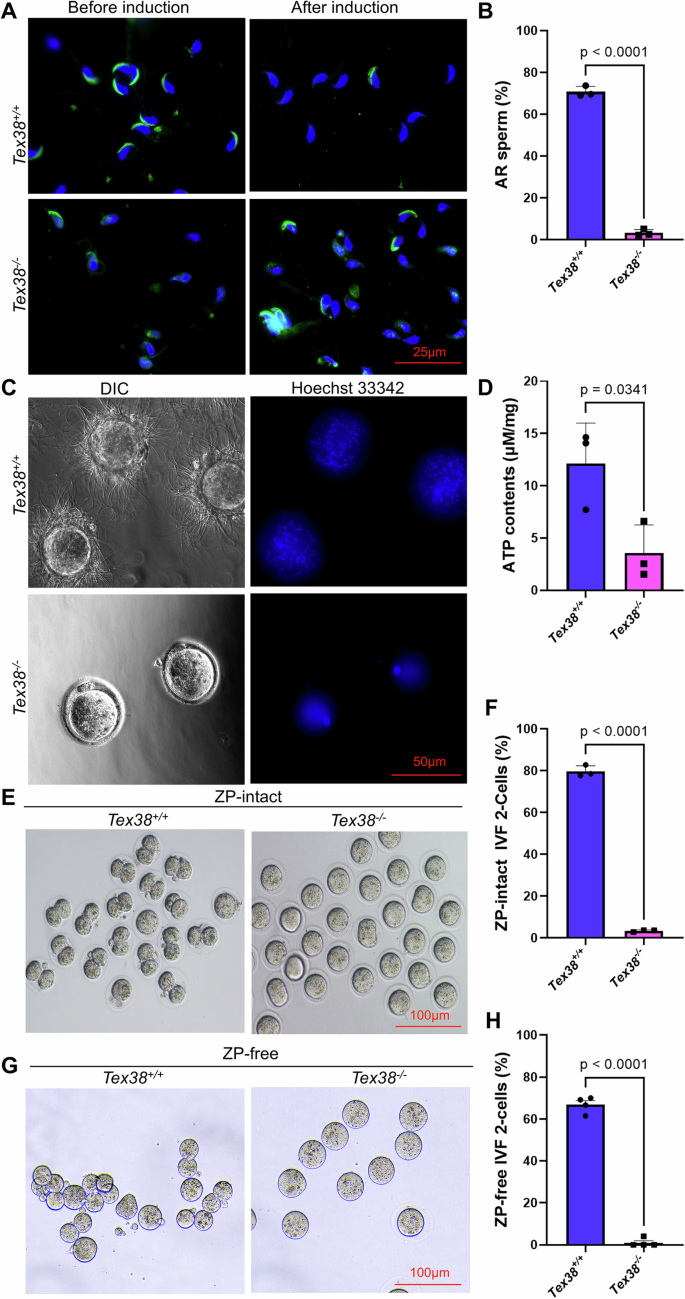
A Sperm from Tex38+/+ and Tex38−/− mice was induced by calcium ionophore A23187 supplementation and PNA staining was performed. Nuclei were counterstained with DAPI. Representative images were shown. Scale bar is 25 μm. B Quantification of the percentages of acrosome reaction (AR) in (A) (n = 3, more than 200 sperm per replicate). Student’s t-test. C In vitro analysis of sperm–egg binding. Sperm heads were stained with Hoechst 33342. Scale bar is 50 μm. D ATP contents in Tex38+/+ and Tex38−/− sperm (n = 3). Student’s t-test. E Zona pellucida (ZP) intact oocytes after 24 h of in vitro fertilization (IVF) with epididymal sperm from adult Tex38+/+ or Tex38−/− mice. Scale bar is 100 μm. F Quantification comparison of 2-cell rate following IVF of Tex38+/+ ZP intact oocytes with epididymal sperm from adult Tex38+/+ or Tex38−/− mice (n = 3). Student’s t-test. G ZP free oocytes after 24 h of IVF with epididymal sperm from adult Tex38+/+ or Tex38−/− mice. Scale bar is 100 μm. H Quantification comparison of 2-cell rate following IVF of Tex38+/+ ZP free oocytes with epididymal sperm from adult Tex38+/+ or Tex38−/− mice (n = 4). Student’s t-test. Data are mean ± SEM and dots represent values for individual mice.
The absence of TEX38 impairs the processing and maturation of ADAM3 and its associated chaperone proteins in epididymal sperm
To elucidate the molecular mechanisms underlying TEX38 deletion-induced male infertility, we performed proteomic analyses on proteins extracted from testis, sperm, and epididymis. The histogram illustrates the distribution of DEPs (fold change ≥1.5), revealing 1290 DEPs in Tex38−/− sperm and 445 DEPs in the epididymis, in contrast to only 37 DEPs identified in the testis (Fig. 6A and Supplementary Data 1). GO enrichment analysis revealed few enriched biological processes among testis DEPs in Tex38−/− mice, whereas DEPs in sperm and epididymis were both enriched in flagellated sperm motility, spermatogenesis, and sperm-ZP binding (Fig. 6B). Sperm DEPs were additionally enriched in other biological processes, including cilium movement and sperm axoneme assembly, while epididymis DEPs were enriched in lipid metabolic process, actin filament organization, and cilium movement involved in cell motility (Fig. 6B). Among all DEPs, CALR3 exhibited the most dramatic elevation in sperm following Tex38 deletion. As a molecular chaperone, CALR3 works synergistically with CLGN and PDILT to facilitate ADAM3 folding for sperm-ZP binding12,13,14,15,16. Consequently, we examined DEPs associated with ADAM3 folding. As depicted in Fig. 6D, F, mature ADAM3 was downregulated in Tex38−/− sperm and epididymis. Correspondingly, CALR3, CLGN, and PDILT protein expression was significantly increased in the Tex38−/− sperm and/or epididymis. Collectively, these findings suggest that TEX38 interacts with molecular chaperones to promote mature ADAM3 production for sperm-ZP binding.
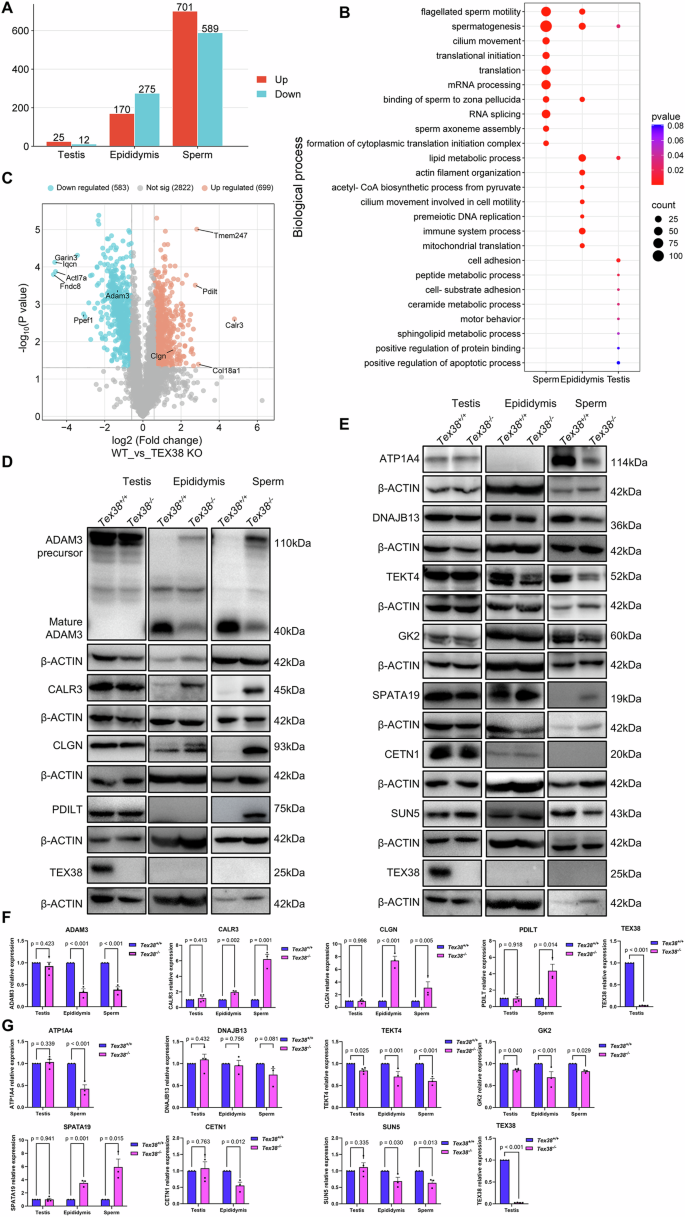
Protein of adult mouse testis, sperm, and epididymis was extracted for proteomics analysis. A Histogram diagram shows the number of up-regulated and down-regulated differentially expressed proteins in the testis, epididymis, and sperm of Tex38−/− mice. B Top biological process from GO enrichment analysis of DEPs in Tex38−/− sperm, epididymis and testis. C Volcano plot of differentially expressed proteins between Tex38+/+ and Tex38−/− sperm. Red dots represent upregulated proteins, blue dots represent downregulated proteins, and gray dots represent proteins that were not differentially expressed (P < 0.05, |logFC | >1.5). D Protein expressions of ADAM3, CALR3, CLGN, PDILT in Tex38+/+ and Tex38−/− testis, epididymis, and sperm. E Protein expressions of TEX38, ARRDC5, ATPA14, DNAJB13, TEKT4, GK2, SPATA19, SUN5, and CETN1 in Tex38+/+ and Tex38−/− testis, epididymis, and sperm. F, G Quantitation of protein expressions in (D) and (E) (n = 3). Mann-Whitney U test.
Notably, flagellated sperm motility, sperm mitochondrial sheath assembly, and sperm-ZP binding were common to both sperm and epididymis DEPs. To validate these findings, Western blot analysis assessed protein expression in testis, epididymis, and sperm. Figure 6E showed that TEX38 protein expression was absent in the Tex38−/− testis, while no signaling was detected in the epididymis and sperm. Additionally, Western blot analysis revealed significant decreases in TEKT4, GK2, and SUN5 expression in both Tex38−/− epididymis and sperm, along with increased SPATA19 levels. ATP1A4 and DNAJB13 were significantly decreased in Tex38−/− sperm, while CETN1 was downregulated in KO epididymis (Fig. 6E, G). Collectively, these findings demonstrate that TEX38 deficiency not only affects sperm HTCA formation and flagellar assembly proteins but also leads to significant alterations in the maturation of ADAM3 and its associated chaperone proteins in both sperm and epididymis.
ARRDC5, a novel interacting protein of TEX38, deficiency of which leads to similar spermatogenesis defects to those in Tex38
−/− mouse
To investigate the mechanisms by which TEX38 functions in spermatogenesis and fertilization, we employed the STRING database (https://cn.string-db.org) to perform bioinformatic analysis on TEX38 and identify potential interacting proteins. Among these, ARRDC5 emerged as a candidate binding partner (Fig. 7A). We further validated the interaction between TEX38 and ARRDC5 using co-immunoprecipitation (Co-IP) in the HEK-293T cell line (Fig. 7B). Proteomic analysis revealed comparable ARRDC5 expression levels in the testes of Tex38−/− and Tex38+/+ mice; however, ARRDC5 was undetectable in Tex38−/− sperm. This finding was further validated by Western blot analysis (Fig. 7C). The observed interaction prompted a critical inquiry into the fundamental process governing their interplay during spermatogenesis. Accordingly, we first analyzed the expression profile of ARRDC5. Similar to TEX38, ARRDC5 exhibited predominant expression in the mice testis at both the mRNA and protein levels (Fig. 7D, E). Furthermore, the developmental stage-specific expression pattern of ARRDC5 in Arrdc5+/+ mice testis mirrored that of TEX38. Arrdc5 mRNA displayed weak expression from 7 dpp, with a significant increase observed from 28 dpp onwards. Protein expression initiated at 21 dpp, gradually increased and peaked in adulthood (Fig. 7F, G).
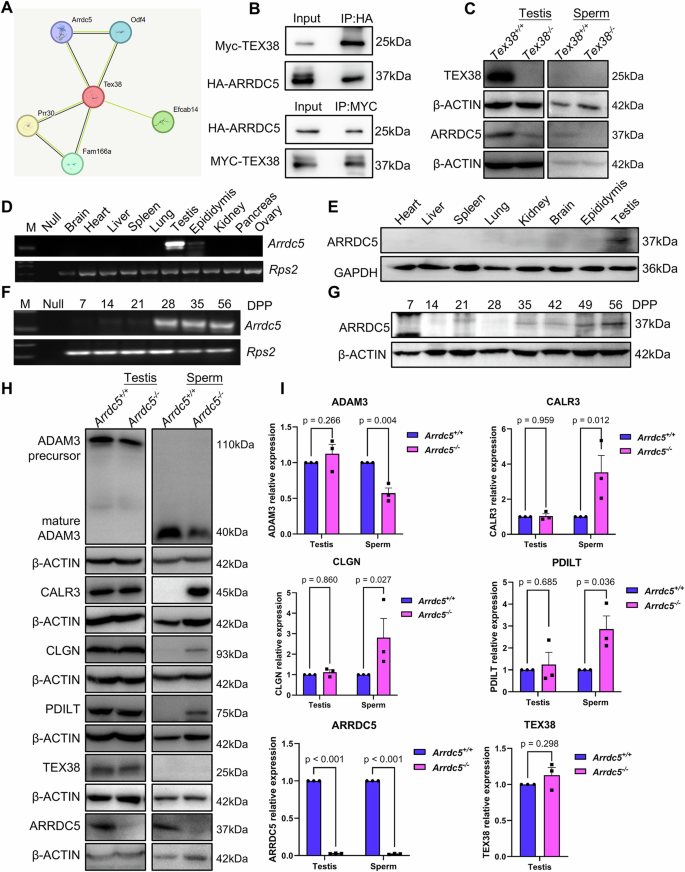
A Screen the interacting proteins of TEX38 in STRING database (https://cn.string-db.org). B ARRDC5 interacted with TEX38 in cultured HEK293T cells. C Protein expression of ARRDC5 in the Tex38+/+ and Tex38−/− testis, epididymis, and sperm. D RT-PCR analysis of Arrdc5 mRNA in mice tissue. Rps2 was used as loading control. E Western blot of ARRDC5 protein in mice tissue. β-actin was used as a control. F RT-PCR analysis of Arrdc5 mRNA in mice developing testis. G Western blot of ARRDC5 protein in mice developing testis. H Protein expressions of ADAM3, CALR3, CLGN, PDILT, TEX38 in Arrdc5+/+ and Arrdc5−/− testis and sperm. I Quantitation of protein expressions in (H) (n = 3). Mann-Whitney U test.
To explore the role of ARRDC5 in male reproduction, given its interaction with Tex38, we generated Arrdc5−/− mice using CRISPR/Cas-mediated genome engineering (Fig. S4A, B). A three-month fertility test revealed complete infertility in Arrdc5 −/−male mice, while female fertility remained unaffected (Fig. S4C). To explore the underlying spermatogenic defects in Arrdc5−/− mice, testes and epididymides from 8- to 10-week-old animals were collected for histological analysis. No significant differences were observed in testis size or testis-to-body weight ratio between Arrdc5−/− and age-matched Arrdc5+/+ mice (Fig. S4D, E). However, sperm counts and motility were significantly reduced in the cauda epididymis of Arrdc5−/− mice compared to Arrdc5+/+ controls (P < 0.05) (Fig. S4F, G). H&E staining of Arrdc5−/− testis sections showed apparently normal spermatogenesis (Fig. S4H), whereas sperm isolated from the cauda epididymis exhibited reduced abundance and various morphological abnormalities, including bent necks, malformed heads, and multiple heads or flagella (Fig. S4H, I). SEM confirmed the abnormal sperm morphology observed in Arrdc5−/− mice, which resembled that of Tex38−/− sperm (Fig. S4J). Additionally, Comet assay analysis revealed significant DNA damage in Arrdc5−/− sperm, indicating impaired sperm DNA integrity (Fig. S4K, L).
To further explore the underlying causes of abnormal sperm, we evaluated the 12 stages of the seminiferous cycle and observed unreleased sperm in stages IX-X of Arrdc5−/− testis (red dashed box), a phenotype similar to the delayed sperm release caused by Tex38−/− (Fig. S5A). To determine whether Arrdc5-deficient abnormal sperm originated in the epididymis, as in the case of Tex38, we compared sperm number and morphology in the testis, caput, corpus, and cauda epididymis of Arrdc5−/− and Arrdc5+/+ mice (Fig. S5B, C). Interestingly, while Arrdc5−/− testicular tissue exhibited a higher proportion of malformed heads (KO 24.8% vs WT 3.3%, P < 0.05) and multi-headed/flagellated sperm (KO 8.9% vs WT 0%, P < 0.05), there was no significant difference in bent-neck sperm compared to Arrdc5+/+ testis (KO 3.2% vs WT 4.3%, P > 0.05). However, the proportion of bent-neck sperm increased significantly upon entering the epididymis and remained elevated in the caput (KO 44.2% vs. WT 2.6%), corpus (KO 51.7% vs. WT 3.4%), and cauda (KO 49.6% vs. WT 2.0%) epididymis (P < 0.05). Similarly, the proportion of malformed heads and multi-headed/flagellated sperm showed significant increases and remained relatively stable compared to Arrdc5+/+ testis, caput, corpus, and cauda epididymis (P < 0.05). The proportion of different abnormal sperm types did not change with prolonged sperm maturation time in the epididymis.
Given the phenotypic similarities between Arrdc5−/− and Tex38−/− mice, we hypothesized that ARRDC5, analogous to TEX38, regulates ADAM3 expression and maturation. Western blot analysis of testicular and sperm samples from Arrdc5−/− mice revealed that while TEX38, ADAM3, CALR3, CLGN, and PDILT expression levels in the testes remained unchanged compared to wild-type controls, mature ADAM3 was significantly downregulated in Arrdc5−/− sperm (Fig. 7H, I). Conversely, CALR3, CLGN, and PDILT expression levels were upregulated in Arrdc5−/− sperm, mirroring the expression pattern observed in Tex38−/− mice (Fig. 7H, I). In summary, ARRDC5, an interacting protein of TEX38, contributes to spermiogenesis and ADAM3 maturation, phenotypes resembling those of Tex38−/− mice.
TEX38 and ARRDC5 interact with proteins involved in ADAM3 maturation, fertilization, protein transport, and spermiogenesis
Given the similar male infertility phenotypes observed in Tex38−/− and Arrdc5−/− mice, we hypothesized that shared molecular mechanisms underlie these reproductive defects. To identify potential protein interaction partners of TEX38 and ARRDC5 involved in male infertility regulation, we performed IP-MS in WT testes. As depicted in Fig. 8A, we identified 384 binding proteins for TEX38 and 365 for ARRDC5 within the testis. Overlap analysis revealed 172 proteins shared by both TEX38 and ARRDC5 (Fig. 8A and Supplementary Data 2). Gene Ontology (GO) enrichment analysis indicated that binding proteins for both proteins were enriched in biological processes including protein transport, apoptotic process, spermatogenesis, vesicle-mediated transport, and proteolysis (Fig. 8B). The top cellular components were cytoplasm, mitochondrion, and ER (Fig. 8C). The most significant molecular functions were protein binding and identical protein binding (Fig. 8D). Meanwhile, we discovered that the ER molecular chaperones calmegin (CLGN) and protein disulfide isomerase-like, testis expressed (PDILT), which are associated with ADAM3 maturation, are also shared interacting partners of TEX38 and ARRDC5. Co-IP analysis further confirmed that CLGN and PDILT can interact with TEX38 and ARRDC5 in vitro (Fig. 8E, F). These findings reinforce our hypothesis that TEX38 and ARRDC5 may be involved in sperm maturation by influencing the maturation of ADAM3.
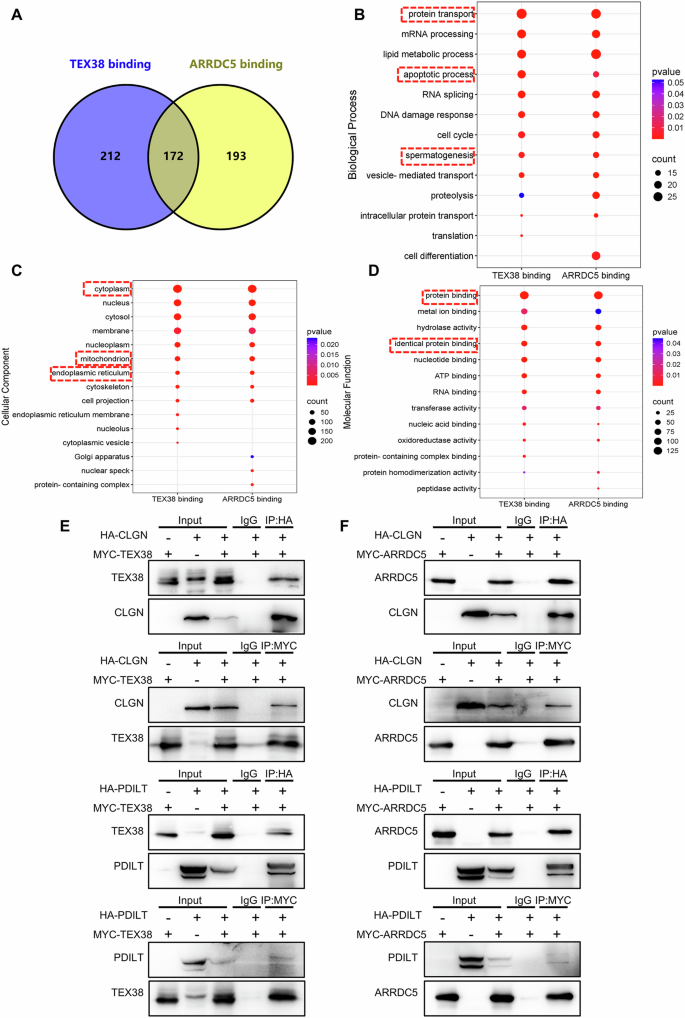
Protein of adult mouse testis was extracted and IP-MS was performed to identify TEX38 and ARRDC5 binding proteins. A Venn diagram shows the overlap of the TEX38 binding proteins and ARRDC5 binding proteins. B Top biological process, C top cellular component, and D top molecular function from GO enrichment analysis of TEX38 and ARRDC5 binding proteins. E, F Co-IP was performed in HEK-293T cells to validate the interactions of CLGN and PDILT with TEX38 and ARRDC5.
Specifically, these binding proteins participate in various aspects of spermatogenesis and fertilization, including: (1) flagellum assembly (e.g., ATP1A4, DNAJB13, SPACA9, and MNS1); (2) flagellar energy metabolism (e.g., TEKT4); (3) mitochondrial sheath assembly (e.g., GK2, SPATA19, and ARMC3); (4) centriole arrangement (e.g., CETN1); (5) fertilization (e.g., LYZL4, CCIN, SPACA3, and PPP3CC); (6) multinucleated giant cell or multi-headed/flagellated sperm formation (e.g., HADH and ZDHHC19); and (7) ER-to-Golgi vesicle-mediated transport (e.g., ERGIC3). Figure S6 illustrates that TEX38 and ARRDC5 interact with common binding partners critical for spermatogenesis and fertilization. Additionally, Co-IP validated the interaction between TEX38 and several of these putative binding partners (Fig. S7).
Tex38
−/− and Arrdc5
−/− spermatozoa failed to pass through the uterine-tubal junction (UTJ)
Given the impaired ADAM3 maturation in Tex38−/− and Arrdc5−/− mice, along with significant differential expression of associated ER chaperones and the shared interaction of TEX38 and ARRDC5 with CLGN and PDILT, we hypothesized that knockout of either gene would disrupt sperm migration through the UTJ. To validate this, we dissected the uterus and oviducts 3.5 h post-coitum, quantified sperm numbers in each segment, and performed histological analysis of the uterine-tubal junction (UTJ) to assess in vivo sperm migration. Approximately 2 × 10⁶ sperm were recovered from the uteri of females mated with WT males. In contrast, sperm counts in females mated with Tex38−/− or Arrdc5−/− males were significantly reduced compared to WT controls (Fig. 9B), this reduction may result from decreased sperm counts in Tex38−/− or Arrdc5−/− males. Nevertheless, 4×10⁵–8×10⁵ sperm were detected in the uteri of females mated with Tex38−/− or Arrdc5−/− males. To further examine sperm migration capacity, we quantified sperm in the oviducts. While 150–200 sperm were present in each oviduct of females mated with WT males, no sperm were detected in the oviducts of females mated with Tex38 Tex38−/− or Arrdc5−/− males (Fig. 9C). Histological analysis confirmed that Tex38−/− or Arrdc5−/− sperm were predominantly retained in the uterus post-ejaculation and rarely reached the oviducts, whereas WT sperm were primarily localized in the oviducts (Fig. 9A). These findings collectively indicate that sperm from Tex38−/− or Arrdc5−/− males exhibit defective migration from the uterus to the oviduct in vivo.
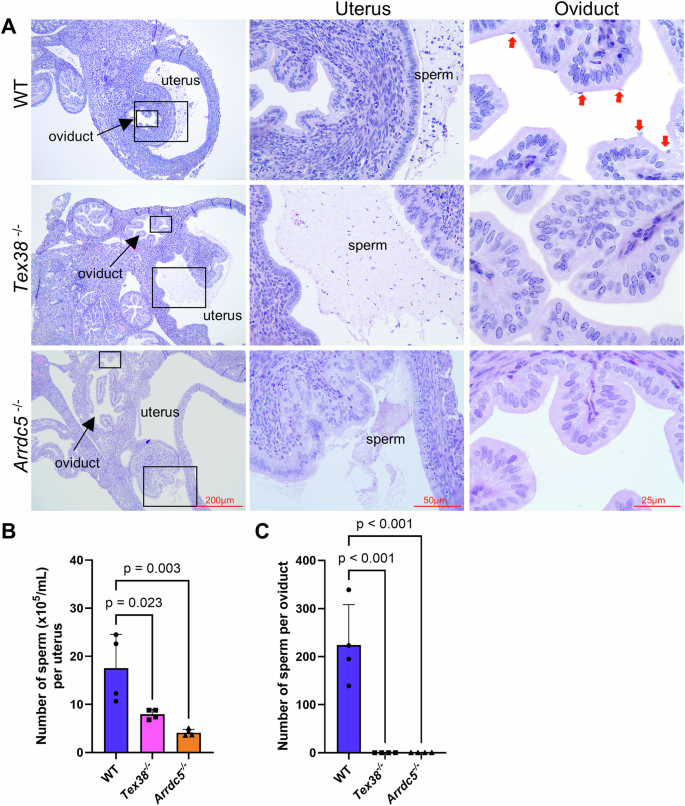
A H&E Cross sections of the UTJ of female mice mated with mice and Tex38−/− (or Arrdc5−/−) mice, respectively. The middle and right panels are rectangular areas with higher magnification for the corresponding left panel. The red arrow represents sperm. B Sperm count in the uterus after coitus. Data are presented as the mean ± SEM. (n = 4), Student’s t-test. C Sperm count in the oviducts after coitus. Data are presented as the mean ± SEM. (n = 4), Student’s t-test.
Tex38
−/− mice can be rescued by intracytoplasmic sperm injection
To probe the potential of intracytoplasmic sperm injection (ICSI) to overcome infertility in Tex38−/− mice, we performed ICSI using spermatozoa from both Tex38+/+ and Tex38−/− males. In the control group, sperm with rapid, progressive motility and normal morphology were selected for injection, while in the experimental group, spermatozoa exhibiting the typical bent-neck phenotype associated with Tex38 deletion were utilized. Three control groups, each comprising 19, 20, and 22 eggs, were injected with tailless sperm. After 24 h of culture, 19, 20, and 22 cells developed into two-cell embryos, and subsequently, 17, 18, and 21 blastocysts formed after 96 h. Similarly, three experimental groups of 17, 17, and 16 eggs were injected. Following 24 h, 12, 15, and 15 two-cell embryos were obtained, with subsequent development into 7, 13, and 12 blastocysts after 96 h (Fig. 10A). Importantly, the rates of two-cell embryo and blastocyst formation from Tex38−/− male mice were not significantly different from those derived from control mice (Fig. 10B). These findings suggest that Tex38 deletion does not overtly impact the development of early embryos produced via ICSI. To further assess the efficacy of ICSI in rescuing Tex38-associated infertility, two-cell embryos were transferred into pseudopregnant female mice, and successfully obtained the healthy developing pups (Fig. 10C). Genotyping of these offspring through PCR amplification of mouse tail DNA confirmed a heterozygous genotype in all cases (Fig. 10D). These results substantiate that ICSI can effectively overcome male infertility caused by Tex38 deficiency.
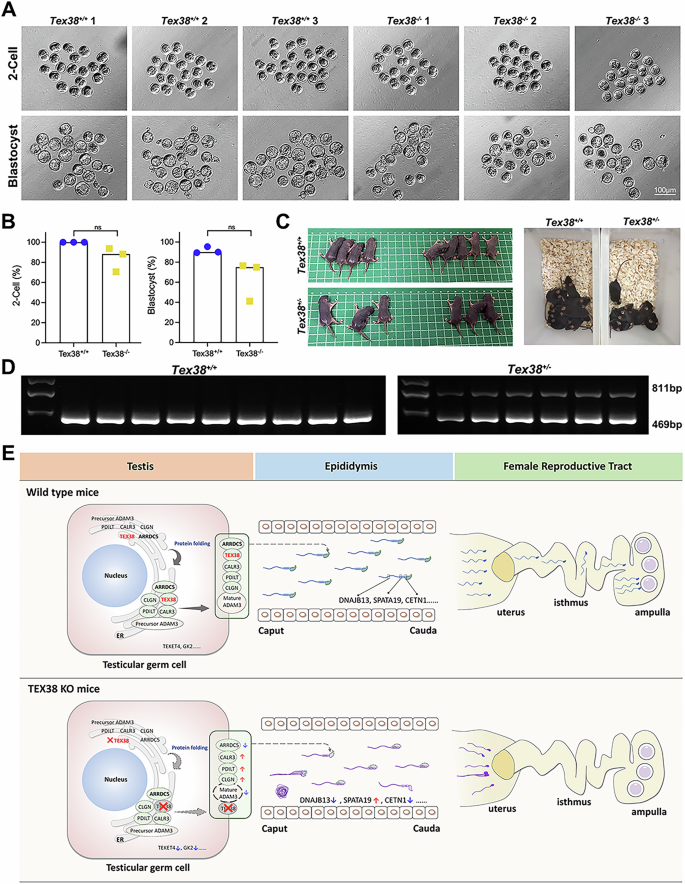
Abnormal spermatozoa from cauda epididymis of Tex38−/− mice were selected for ICSI. A Two-cell and blastocyst embryos after ICSI. The oocytes were fertilized by the sperms from Tex38−/− and Tex38+/+ mice after ICSI. B The proportion of 2-cell and blastocyst embryos after ICSI in Tex38−/− and Tex38+/+ mice. Data are mean ± SEM and dots represent values for individual mice (n = 3). C The offspring of the Tex38+/− and Tex38+/+ mice were born and grew healthy after ICSI. D Genotyping for the newborn pups of Tex38+/− and Tex38+/+ mice by RT-PCR. E Diagram of proposed action of Tex38. This figure was originally created by the authors using PowerPoint.
